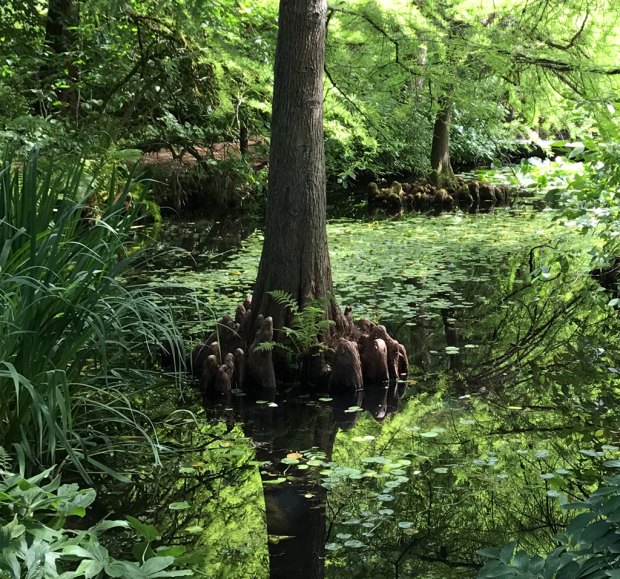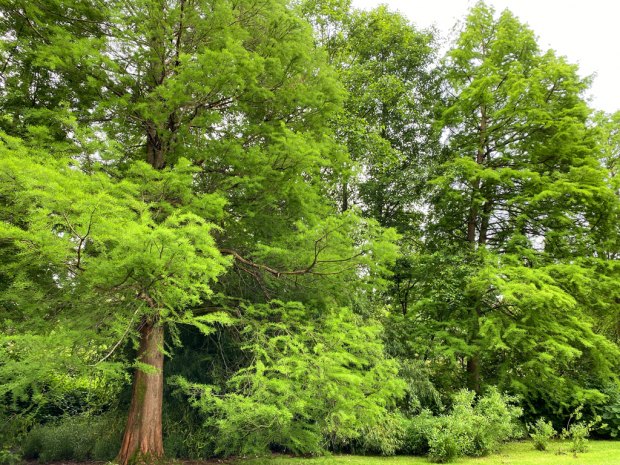
Taxodium distichum is commonly known as baldcypress (one word), which is a useful name that describes its habit, saying it looks a bit like a cypress that goes bald. In other words, it is a deciduous conifer with needles, and it is in the cypress family, Cupressaceae.
Leaves on a baldcypress are delicate, feathery fronds of needles growing in two fairly flat, pinnate ranks; hence, its specific name of distichum, which means two-ranked. The leaves are reminiscent of the short and flat leaves of Taxus, the yew. But baldcypress leaves, which grow spirally on a branch, have more pointed tips and are more delicate than yew leaves.
Baldcypress loves wet ground and in such terrain, it has the unusual habit of growing roots known as “knees”—knobby roots that surround the main trunk and probably give it extra stability in the wet soil. It is thought that the knees are something to do with “coming up for air,” when the waterlogged soil is too wet to allow much oxygen to remain in the water. This is a species that tolerates flooding well.
The native habitat for Taxodium distichum is Louisiana swampland. There, it is frequently called swampcypress or pondcypress, which puts less emphasis on its winter baldness. This is important, because in its native clime, this tree tends to be an evergreen.
Being a long-lived tree that is capable of growing to between 15 m and 20 m tall and from 6 m to 14 m wide, this species suits a large space, such as a park. Also its knees make it unfriendly to walkers and lawnmowers. The City of Vancouver has planted only four as boulevard trees, considering them unsuitable for that purpose.
A grove of baldcypress grows in VanDusen Botanical Garden, in a way that is similar to how the species grows in its homeland, in standing water. Others grow in the Cambie Heritage Boulevard.
Six or more of them grow together in Stanley Park between the north side of the Pitch & Putt and the Lost Lagoon walking path. These have fewer knees than the VanDusen individuals, perhaps because the oxygenation of the soil beside the Lost Lagoon walking path is better.
Taxodium distichum comes to life in mid-June in Stanley Park
The trunk of one of the Stanley Park baldcypresses displays an ess curve, which becomes even more noticeable after the leaves have fallen. How did this come about?
As our November days cool and the hours of daylight shrink, baldcypress prepares for winter, its leaves turning from summer green to a light rosy brown. The beauty is magical.
Baldcypress fronds change colour from November to December
I have not been lucky enough to see cones on a baldcypress. Apparently, the species flowers (female seed cones and male pollen cones) in April and the wind-pollinated mature cones are evident by October. Once fully mature, the cones shatter to spread their seed, leading to the species often growing as a grove.
Baldcypress is similar to dawn redwood (Metasequoia glyptostroboides) in that in southern British Columbia, they are both deciduous conifers. Even so, these members of the Cupressaceae family sport several differences: tree shape, needles, trunk, and knees. Where dawn redwood tends to retain its strictly pyramidal habit as it ages, baldcypress grows less uniformly, spreading quite broadly.
Where dawn redwood needle colour ranges from hunter green in spring to a flaxen cream in fall, baldcypress ranges from a sharp lime green in spring through rosy brown to an ochre before the leaves fall. Finally, the regular depressions that occur below a dawn redwood’s branches (sometimes called “armpits”) do not occur in a baldcypress. And of course, there are the baldcypress’s knees.
Flaxen-coloured dawn redwood leaf among ochre-coloured baldcypress leaves.
Trunk of baldcypress is fairly uniform in shape; close-up shows lichen growth.
Knees on baldcypress
photos and text Nina Shoroplova, Vancouver Master Gardener Student
Sources:
https://conifersociety.org/conifers/taxodium-distichum/
Vancouver Trees app, University of British Columbia, 2015
www.missouribotanicalgarden.org





















